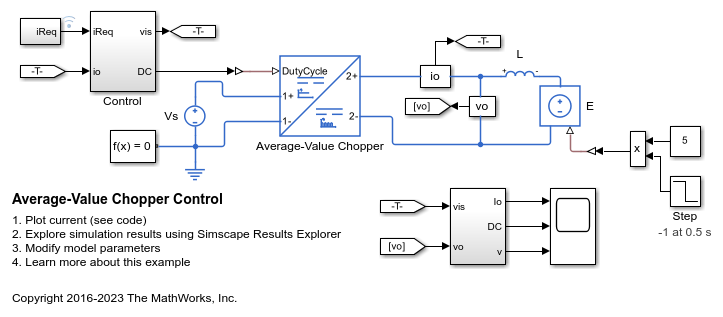Crear y simular redes de sistemas de potencia electrónicos, mecatrónicos y eléctricos
Aprenda técnicas esenciales de modelado y simulación, por ejemplo:
Conmutar entre puertos trifásicos compuestos y expandidos
Conmutar entre señal física y puertos eléctricos
Simular efectos térmicos con puertos térmicos
Temas
- Essential Electrical Modeling Techniques
Apply Simscape™ modeling rules when you build electronic, mechatronic, and electrical power system networks using Simscape Electrical™.
- Three-Phase Ports
Connect three-phase blocks using composite ports for three-phase lines or expanded ports for single-phase lines.
- Switch Between Physical Signal and Electrical Ports
Switch between a physical signal port and an electrical conserving port on a Simscape Electrical block.
- Selecting the Output Model for Logic Blocks
Explore the two output models available for logic blocks.
- Simulating an Electronic, Mechatronic, or Electrical Power System
Explore best practices and techniques for simulating Simscape Electrical models.
- Simulating Thermal Effects in Semiconductors
Simulate generated heat and device temperature by using the thermal ports.
- Simulating Thermal Effects in Rotational and Translational Actuators
Simulate generated heat and device temperature by using the thermal ports.
- Photovoltaic Thermal (PV/T) Hybrid Solar Panel
Model a multi-domain power cogeneration system using Simscape, Simscape Electrical, and Simscape Fluids™.
- Build and Simulate a Single-Phase Half-Bridge Inverter with Ideal Switches
Build a Simscape Electrical model of a single-phase half-bridge inverter with ideal switches, run the model, and examine the results.
- Build and Simulate Single-Phase Half-Bridge Inverter with Ideal Switches and Thermal Port
Build a Simscape Electrical model of a single-phase half-bridge inverter with ideal switches and a thermal port, run the model, and examine the results.














